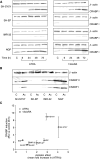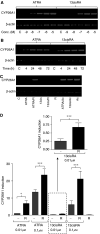Increasing the intracellular availability of all-trans retinoic acid in neuroblastoma cells
- PMID: 15714209
- PMCID: PMC2361877
- DOI: 10.1038/sj.bjc.6602398
Increasing the intracellular availability of all-trans retinoic acid in neuroblastoma cells
Abstract
Recent data indicate that isomerisation to all-trans retinoic acid (ATRA) is the key mechanism underlying the favourable clinical properties of 13-cis retinoic acid (13cisRA) in the treatment of neuroblastoma. Retinoic acid (RA) metabolism is thought to contribute to resistance, and strategies to modulate this may increase the clinical efficacy of 13cisRA. The aim of this study was to test the hypothesis that retinoids, such as acitretin, which bind preferentially to cellular retinoic acid binding proteins (CRABPs), or specific inhibitors of the RA hydroxylase CYP26, such as R116010, can increase the intracellular availability of ATRA. Incubation of SH-SY5Y cells with acitretin (50 microM) or R116010 (1 or 10 microM) in combination with either 10 microM ATRA or 13cisRA induced a selective increase in intracellular levels of ATRA, while 13cisRA levels were unaffected. CRABP was induced in SH-SY5Y cells in response to RA. In contrast, acitretin had no significant effect on intracellular retinoid concentrations in those neuroblastoma cell lines that showed little or no induction of CRABP after RA treatment. Both ATRA and 13cisRA dramatically induced the expression of CYP26A1 in SH-SY5Y cells, and treatment with R116010, but not acitretin, potentiated the RA-induced expression of a reporter gene and CYP26A1. The response of neuroblastoma cells to R116010 was consistent with inhibition of CYP26, indicating that inhibition of RA metabolism may further optimise retinoid treatment in neuroblastoma.
Figures





References
-
- Åstrom A, Pettersson U, Krust A, Chambon P, Voorhees JJ (1990) Retinoic acid and synthetic analogs differentially activate retinoic acid receptor dependent transcription. Biochem Biophys Res Commun 173: 339–345 - PubMed
-
- Blaese MA, Santo-Hoeltje L, Rodemann HP (2003) CRABP I expression and the mediation of the sensitivity of human tumour cells to retinoic acid and irradiation. Int J Radiat Biol 79: 981–991 - PubMed
-
- Bland M (2000) An Introduction to Medical Statistics, 3rd edn. Oxford: Oxford University Press
-
- Boylan JF, Gudas LJ (1992) The level of CRABP-I expression influences the amounts and types of all-trans-retinoic acid metabolites in F9 teratocarcinoma stem cells. J Biol Chem 267: 21486–21491 - PubMed
Publication types
MeSH terms
Substances
LinkOut - more resources
Full Text Sources

